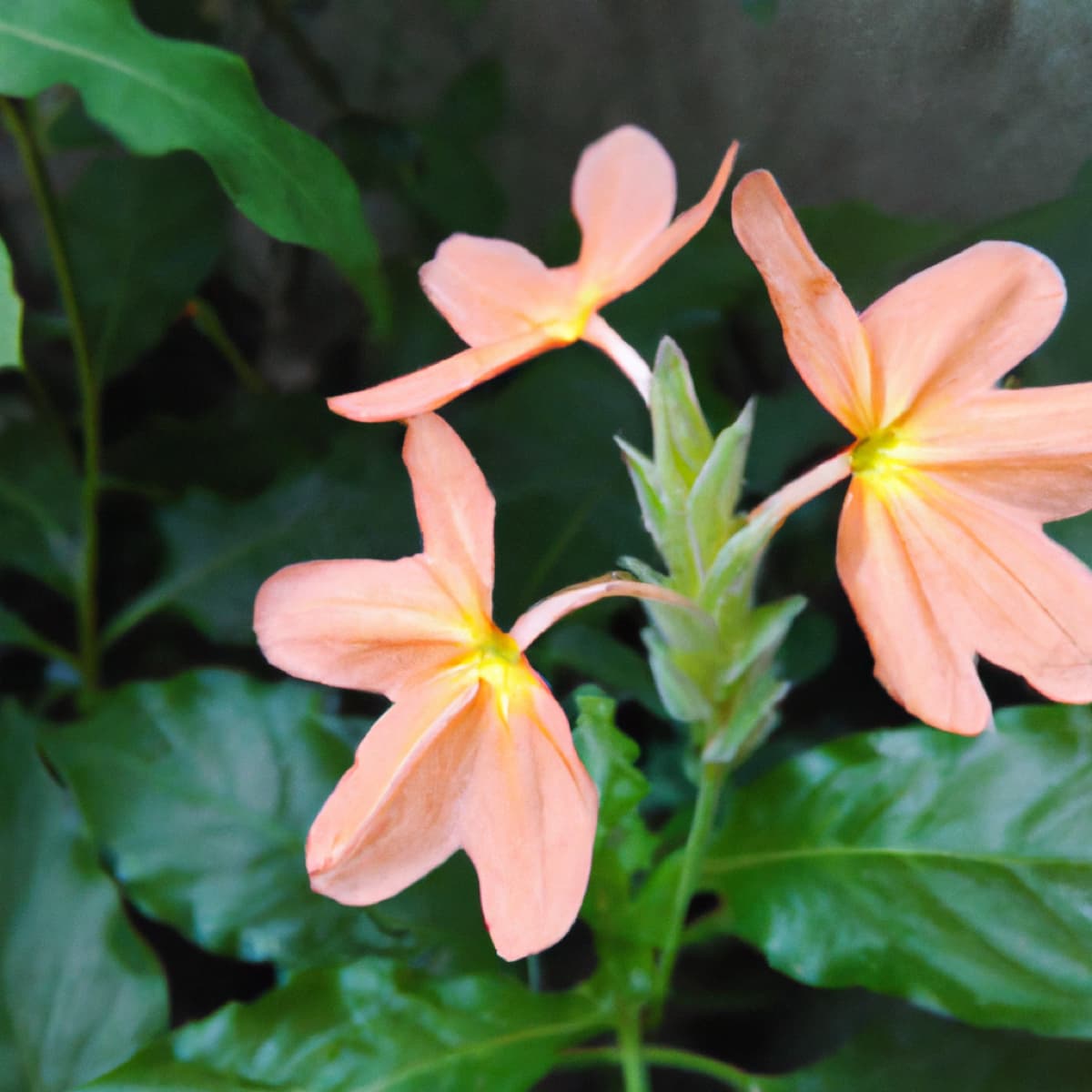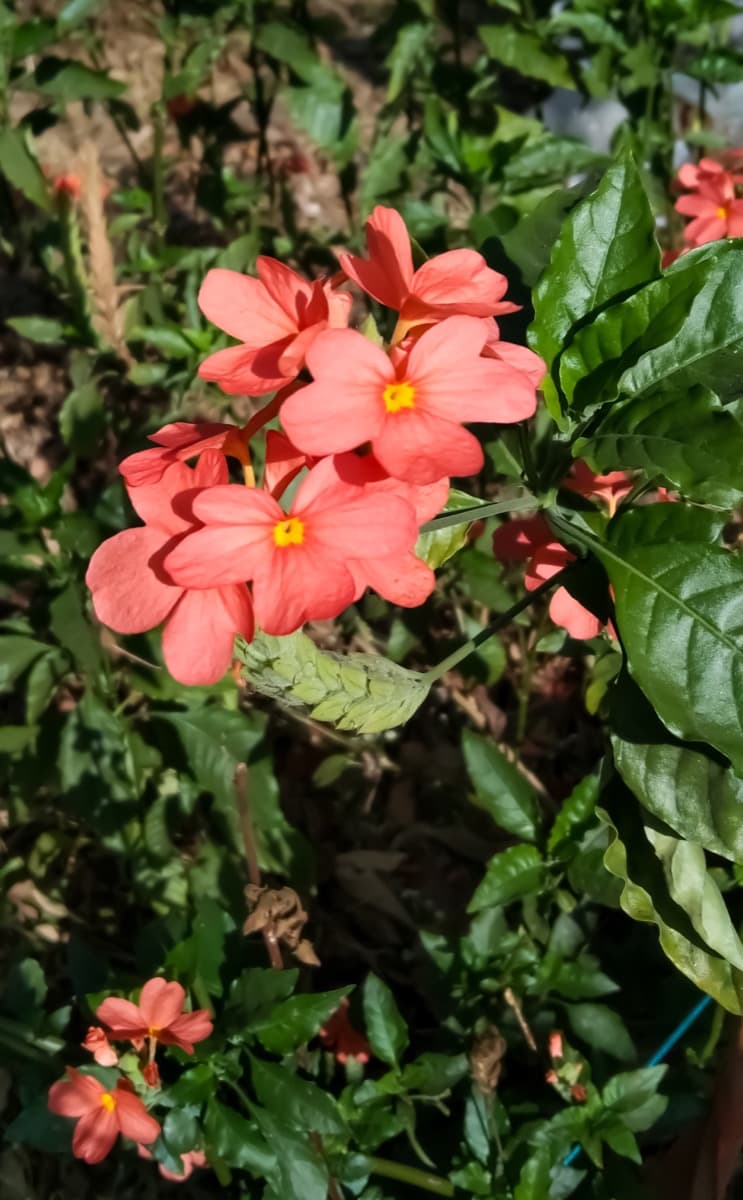Welcome to our blog on Common Crossandra plant diseases and control! This article will explore the causal organisms, damage symptoms, spread, treatment options, prevention strategies, and management techniques for these diseases. Take part with us as we investigate several methods for safeguarding your Crossandra plants while ensuring high-quality yields. Let’s check out more information on how to identify and treat Crossandra diseases below.

Major and Common Damaging Crossandra Diseases
Crossandra is a herbaceous flowering perennial in the Acanthaceae family, native to the tropical regions of India and Sri Lanka. These plants are known for their vibrant and eye-catching blooms. They are admired for their attractive foliage, which is often glossy and deep green. The flowers, borne in dense clusters, display various orange, yellow, and pink hues. Crossandra plants are valued for their ornamental appeal and are commonly cultivated in gardens and as indoor potted plants, adding a splash of color and beauty to any space.
| Disease | Characteristic Symptoms |
| Alternaria Leaf Spot | Dark spots surrounded by concentric rings & target-like appearance. |
| Root Rot | Soft and mushy roots, wilting and yellowing of leaves, & foul odor. |
| Powdery Mildew | White, powdery, fungal growth, browning, & dieback. |
| Stem Rot | Water-soaked lesions, & stem constriction. |
| Anthracnose | Sunken lesions & reduced seed production. |
| Bacterial Leaf Spot | Water-soaked lesions, extensive blighting, & dieback. |
| Fusarium Wilt | Wilting & brown discoloration of the vascular tissues. |
| Mosaic | Mosaic patterns, stunting, and deformed leaves. |
| Pythium Blight | Water-soaked lesions, & plant collapse. |
| Stem Canker | Sunken and necrotic lesions, and dieback of branches. |
How to Identify and Treat Crossandra Diseases
Alternaria Leaf Spot Disease Control in Crossandra
- Causal Organism: Alternaria amaranthi var. crossandrae.
- Symptoms: The characteristic symptom is circular to irregularly shaped dark brown to black spots on leaves. Spots may develop concentric rings within them, creating a target-like appearance. Infested leaves show extensive blighting, chlorosis, and premature leaf drop.
- Spread: Fungal spores are dispersed via wind, splashing water, and infected debris.
- Treatment and Management: Spray chlorothalonil, mancozeb, benomyl, carbendazim, or azoxystrobin. Practice sanitation and dispose of infected plant material. Provide proper spacing and drip irrigation to improve air circulation and reduce humidity.
Root Rot Disease Control in Crossandra
- Causal Organism: Phytophthora nicotianae
- Symptoms: The most prominent symptom is that the roots become brown, soft, and mushy. The plants that are Infected exhibit wilting and yellowing of leaves, foul odor, stunted growth, and reduced vigor.
- Spread: Soil-borne fungal spores or mycelium spread via contaminated soil due to overwatering and poor drainage.
- Treatment and Management: Perform soil drenching with mefenoxam, captan, metalaxyl, or fosetyl-aluminum. Plant in well-draining soils and avoid overwatering. Provide proper plant spacing for good air circulation.
In case you missed it: How to Identify and Manage Common Crossandra Pests: Damage Symptoms, Prevention, and Control

Powdery Mildew Disease Control in Crossandra
- Causal Organism: Oidium spp.
- Symptoms: The primary symptom is the formation of white, powdery, fungal growth on the upper surface of leaves, stems, and flowers. Infected plants show leaf yellowing, browning, curling, distortion, and dieback.
- Spread: Fungal spores are airborne and spread via wind in areas with high humidity and moderate temperatures.
- Treatment and Management: Spray sulfur, neem oil, or potassium bicarbonate at the first sign of infection. Prune affected plant parts and improve air circulation by providing adequate spacing between plants.
Stem Rot Disease Control in Crossandra
- Causal Organism: Rhizoctonia solani
- Symptoms: The characteristic symptom is soft, water-soaked, dark brown to black lesions that appear mushy or waterlogged and fluffy white, cottony mycelium on the stems. Infected plant parts show wilting and yellowing of affected stems, stem constriction, and stunted growth.
- Spread: Sclerotia are soil-borne and spread via soil contamination, direct contact, water splashes, and infected debris.
- Treatment: Spray azoxystrobin, propiconazole, or thiophanate-methyl. Practice soil sterilization, plant spacing, sanitation, and crop rotation, and avoid overwatering and plant stress.
Anthracnose Disease Control in Crossandra
- Causal Organism: Colletotrichum gloeosporioides
- Symptoms: The characteristic symptom is dark, sunken lesions with distinct margins that will develop on leaves, stems, and flowers. Infected tissues may crack or split, leading to secondary infections. Infected flowers may fail to develop properly, leading to reduced seed production.
- Spread: Fungal spores disperse via rain splash, wind, insects, or contaminated gardening tools.
- Treatment: Apply copper hydroxide, copper sulfate, chlorothalonil, azoxystrobin, thiophanate-methyl, or mancozeb. Prune and destroy infected plant parts. Avoid overhead watering and maintain proper plant spacing.
Bacterial Leaf Spot Disease Control in Crossandra
- Causal Organism: Xanthomonas campestris
- Symptoms: The characteristic symptom is the water-soaked lesions on leaves surrounded by yellow halos. Lesions may coalesce, leading to extensive blighting. Infected leaves show wilting, dieback, and necrosis.
- Spread: The bacteria spread via water splashes, rain, irrigation, and infected plant debris or tools.
- Treatment: Spray copper hydroxide or copper sulfate at the first sign of infection. Avoid overhead watering to minimize splashing and spread of bacteria. Use clean tools and sanitize them after each use.
Fusarium Wilt Disease Control in Crossandra
- Causal Organism: Fusarium solani
- Symptoms: The prominent symptom is wilting, starting from the lower leaves and progressing upwards. Infected leaves may turn yellow or brown, and veins remain green. Cutting the stem open may show brown discoloration of the vascular tissues.
- Spread: Soil-borne chlamydospores spread via the movement of infested soil, water, or infected plant material. Insects and nematodes can also act as vectors.
- Treatment and Management: Apply phorate and spray copper oxychloride, carbendazim, benomyl, propiconazole, tebuconazole, or thiophanate-methyl. Practice crop rotation and avoid planting in previously infected soils.
Crossandra Mosaic Disease Control in Crossandra
- Causal Organism: Crossandra Mosaic Virus, Potyvirus, Cucumovirus
- Symptoms: The primary symptom is the formation of mosaic patterns on leaves. Leaves may show yellow, green, and dark green patches, making a mosaic-like appearance. Growth abnormalities, such as stunting and deformed leaves, may also occur.
- Spread: The viruses are transmitted via insect vectors like aphids that consume infected plant sap and by mechanical means like pruning or handling.
- Treatment and Management: Spray copper hydroxide, copper sulfate, or fosetyl-aluminum. Proper sanitation and insect control are essential to prevent transmission. Use virus-free planting material. Remove and destroy infected plants to prevent the spread.
Pythium Blight Disease Control in Crossandra
- Causal Organism: Pythium aphanidermatum
- Symptoms: The primary symptom is the formation of water-soaked lesions on leaves and stems. Lesions enlarge, turn dark brown, and may have a greasy appearance. Infected tissues may rot and disintegrate, leading to plant collapse.
- Spread: Pathogen spreads via water and moist soil, facilitating the movement of motile zoospores or mycelium.
- Treatment and Management: Perform soil drenching with mefenoxam or fosetyl-aluminum. Avoid overwatering and improve soil drainage. Remove and destroy infected plant material.
In case you missed it: How to Identify and Treat Croton Diseases: Damage Symptoms, Prevention, and Control

Stem Canker Disease Control in Crossandra
- Causal Organism: Diaporthe phaseolorum
- Symptoms: The characteristic symptom is the formation of sunken, necrotic lesions on stems, often near nodes or wounds. The lesions may expand and girdle the stem, leading to wilting and dieback of affected branches. Infected stems become brittle and may break easily.
- Spread: The pathogen spreads via wind, rain, contaminated pruning tools, or infected plant debris. Wounds or injuries on the plant act as entry points for the pathogen.
- Treatment: Spray azoxystrobin, propiconazole, or thiophanate-methyl. Prune and destroy infected branches. Avoid injuring the plant and maintain good hygiene practices.
Conclusion
Some major diseases affecting Crossandra plants include alternaria leaf spot, root rot, powdery mildew, stem rot, anthracnose, bacterial leaf spot, fusarium wilt, mosaic, pythium blight, and stem canker disease. Various organisms cause these diseases and exhibit specific symptoms, modes of spread, and management approaches.
- Deworming Schedule for Dogs/Puppies: A Beginners Guide
- How to Prevent and Control Parasites in Goats
- Beneficial Insects in Pest Management
- Natural Solutions for Pest Control in Flower Gardens
- Types of Fungicides Used in Agriculture
- Common Issues in the Fruit Development Stage of Pomegranate Farming
- Fruit Development Issues in Papaya: Easy Solutions and Treatment
- Soil-Borne Diseases and How to Protect Your Plants
- Practices to Prevent Disease Spread in the Garden